Additional Results
Number of Participants in Phase 1
Number of Participants in Phase 2
Number of Participants in Pre-studies & Ablation Studies
Notations
E-Score denotes extroversion measured by users from survey question 1, A-Score denotes agreeableness answerd from survey question 2.
Agr., Dis., Ext., and Int. denote agreeable, disagreeable, extroverted, and introverted persona, respectively.
* denotes 0.01 < p < 0.05, ** denotes p < 0.01, and *** denotes p < 0.001. The error bars represent 95% confidence intervals. The significance level was 0.05
| Number of Participants | Extroverted Persona | Introverted Persona | Sum |
|---|---|---|---|
| Agreeable Persona | Extroverted and Cooperative (13) | Introverted and Cooperative (13) | 26 |
| Disagreeable Persona | Extroverted and Uncooperative (13) | Introverted and Uncooperative (13) | 26 |
| Sum | 26 | 26 | 52 |
| Minions | Cowardly Lion | Scrooge | Spock | Total | 27 | 27 | 27 | 27 | 108 |
|---|
| No Facial Expression (Screen off) | Random Facial Expression | Random Motion | Total | 16 | 24 | 24 | 64 |
|---|
E-Score denotes extroversion measured by users from survey question 1, A-Score denotes agreeableness answerd from survey question 2.
Agr., Dis., Ext., and Int. denote agreeable, disagreeable, extroverted, and introverted persona, respectively.
* denotes 0.01 < p < 0.05, ** denotes p < 0.01, and *** denotes p < 0.001. The error bars represent 95% confidence intervals. The significance level was 0.05
Phase 1 - Satisfaction among Personality Personas
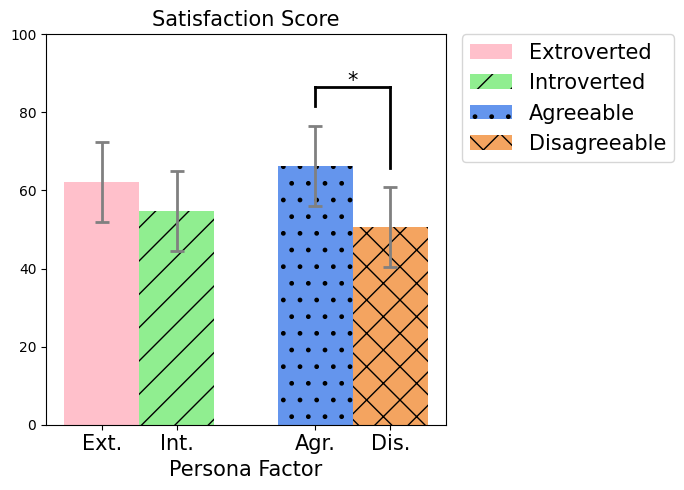
Satisfaction obtained from survey phase 1 question 3.
Analyze Method: two-way ANOVA, fixed factors are extroversion persona and agreeable persona and the dependent variable is satisfaction score.
Results: Significant differences between agreeable and disagreeable personas (F(1,48) = 4.799, p = 0.033, partial η2 = 0.091). No significiant difference between extroversion persona factor.
Phase 2 - Mentioned Keywords among Character Personas
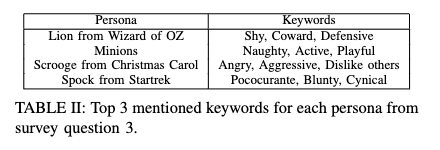
Keywords obtained from survey phase 2 question 4.
Phase 2 - Satisfaction among Character Personas
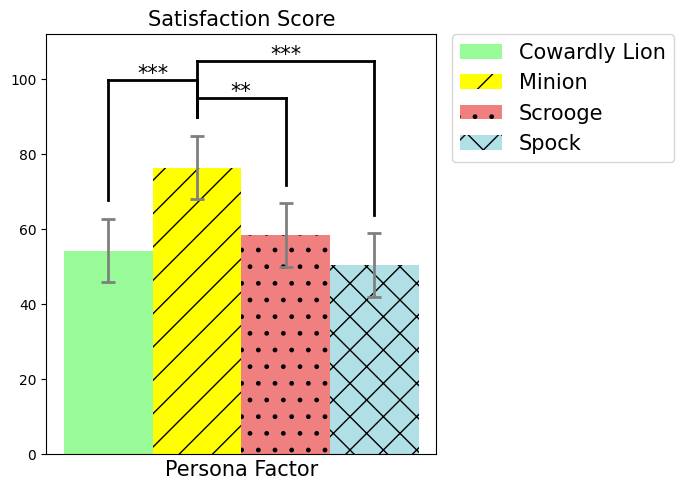
Satisfaction obtained from survey phase 2 question 7.
Analyze Method: one-way ANOVA, fixed factor is persona and the dependent variable is satisfaction score.
Results: Significant differences between personas (F(3,104) = 7.300, p < 0.001, partial η2 = 0.174).
With a post-hoc test, we observed that there was a significant satisfaction difference between Minion persona and the rest of characters. Minions - Cowardly lion had p < 0.001, Minions - Scrooge had p = 0.003, and Minions - Coward lion had p < 0.001,.
Phase 2 - Post-study Comments
Minions
1.
Judging by the constant peek-a-boo, it seemed like a friend with a strong sense of playfulness.
Also, since it appeared to yawn when we didn't move, it seemed to get bored quickly if not engaged, representing mischief character.
Also, since it appeared to yawn when we didn't move, it seemed to get bored quickly if not engaged, representing mischief character.
2.
When I see the Minions, it look like Minions, but their large size doesn't seem to match well with my perception.
3.
At first, while being happy to meet for the first time with a mischievous expression, I chose the playful Minion because of its active interactions.
However, from the middle, it seemed to get tired or started showing expressions of annoyance, which also seems to resemble the behavior of a Minion.
However, from the middle, it seemed to get tired or started showing expressions of annoyance, which also seems to resemble the behavior of a Minion.
4.
When I only saw the arm motions, I was confused, but after seeing the facial expressions on the pad, I could clearly understand.
Cowardly Lion
1.
The response was slower than I expected, so it felt somewhat like a sloth, but it often made crying or scared expressions, which made me feel it was closer to the Cowardly Lion. It would have been more interesting if the response speed or the variety of scenarios had been more diverse.
2.
The robot seemed to interpret the action of waving arms as an act of aggression, taking a defensive posture and shedding tears as if it was afraid of humans.
3.
It seems to resemble the expressions seen on the screen, such as looking flustered, scared, or frightened. The hand gestures also appear to match the description as being defensive, but it might be difficult without the screen or hand gestures.
Scrooge
1.
I was confused between Scrooge and the Minions, but it didn't seem to act lively and spirited, so I chose Scrooge haha. Even when the robot ignores or rejects my greeting, I feel a bit upset :(.
It seems like it's because the robot appears to have its own personality!
It seems like it's because the robot appears to have its own personality!
2.
It is always angry. Normally, it reads books.
3.
It does seem to be an angry situation, but I wish there were more diverse actions! It would be nice if it responded to other actions besides just waving hands!
Spock
1.
The difference in facial expressions is not pronounced, making it difficult to discern whether the object has been recognized. It's confusing what emotion making an X sign with the hands is supposed to express.
2. I chose Spock because it is indifferent to people and dislikes approaching them. However, the expression of indifference (making an X sign with the hands) was not very delicate, causing some confusion during the experiment.
3. It seems to be rejecting people and has its mouth tightly closed, so I thought it resembled Scrooge the most.
4. It is impossible to understand the message it is trying to convey, and I am not feeling the interaction.
Pre-studies - Impact of Facial Expression (Personality Persona)
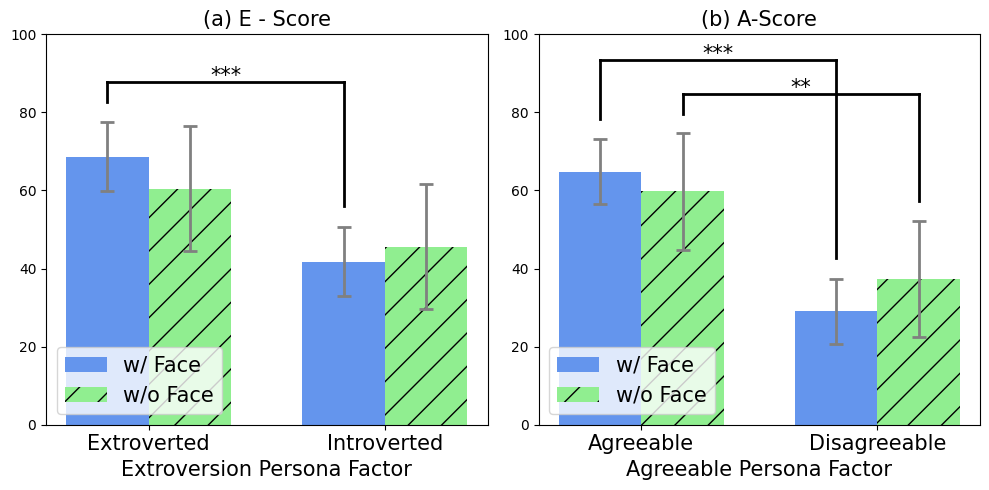
Analyze Method: We employed a 2-way MANOVA, focusing on three key factors: the extroversion and agreeableness of the robot's persona, and the presence or absence of facial expressions.
Results: The analysis revealed that the interaction effect between the facial expression condition and the extroversion persona, in terms of extroversion scores, was not statistically significant (F(1,60) = 0.855, p = 0.329, partial η2 = 0.014 with a significance level 0.05). Similarly, the interaction effect between the facial expression condition and the agreeable persona, in terms of agreeableness scores, also failed to reach statistical significance (F(1,60) = 1.237, p = 0.270, partial η2 = 0.02). Consequently, our study did not find a significant difference attributable to the presence or absence of facial expressions in persona identification.
Ablation-studies - Effect of Motions and Facial Expressions (Personality Persona)
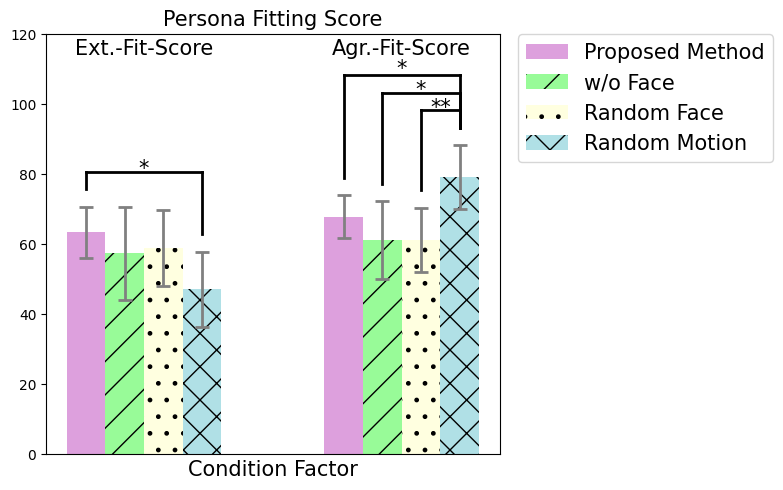
Scoring Method:
- Exroversion Fitting Score (Ext.-Fitting-Score): E-score if persona is extroverted & Otherwise 100- E-score
- Agreeableness Fitting Score (Agr.-Fitting-Score): A-score if persona is agreeable & Otherwise 100- A-score
Comparing Method: No facial expression (Screen off), randomized facial expression, randomized motion
Analyze Method: two-way ANOVA, fixed factor is the ablation condition and the dependent variables are both scores.
Results: Significant differences between Agr.-Fitting-Score (F(3,112) = 3.129, p=0.029, partial η2 = 0.052). Fot post-hoc test, there was a significant difference in Ext.-Fitting-Score of prposed method and randomized motion (p=0.015). In addition, Agr.-Fitting-Score had a significant difference between the same two factor (p=0.046), randomized motion-randimized face (p=0.007), and randomized motion-no face (p=0.015). However, this shows that agreeableness indentification was better when the motion was randomized. As this ablation studies lacks the statisfical power, the results should be interpreted in caution. We have observed that the motion effects significantly in extroversion factor, while the facial expression may be more dominant in understanding the agreeableness of the proposed method.